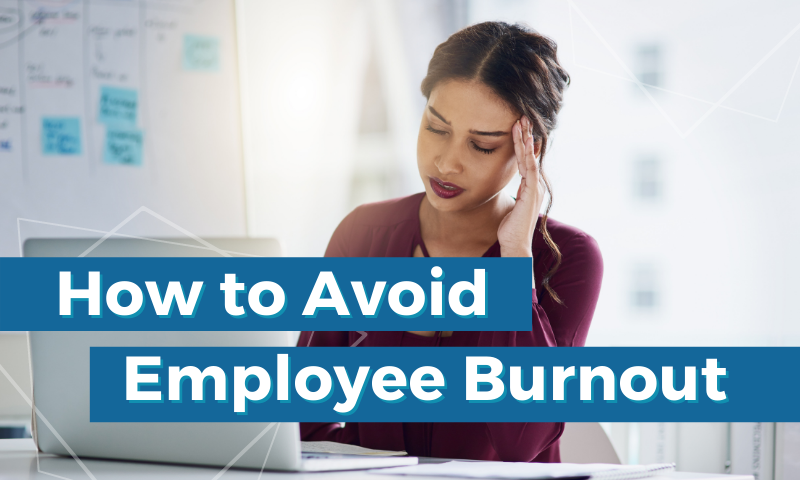If there’s one thing this past year brought upon all of us, it’s stress. Today’s professionals are coping with a lot of pressure, and too much of it can lead to burnout. According to a recent study by Deloitte, 77% of people are experiencing employee burnout at their current job. Today, we’ll explore the signs of burnout and how to prevent it within your company.
What is Burnout?
According to The Maslach Burnout Inventory, burnout is “characterized by emotional exhaustion, cynicism, and ineffectiveness in the workplace, and by chronic negative responses to stressful workplace conditions.” There are multiple signs that could indicate you are suffering from burnout, including emotional, cognitive, and non-specific physical manifestations.
Emotional Manifestations
“I feel tired, and I don’t know how I will make it to Friday.” As dramatic as this sounds, there is a real fear behind that sentence. Emotional and psychological fatigue are very common symptoms of burnout. Mood swings and anxiety are often associated with it. Some tasks that you used to tackle easily now seem impossible. Deedee Cummings, a therapist and author, said “Emotional burnout happens when you have faced such a high level of stress that your body literally shuts down and just cannot accommodate any more challenges.” Look out for those signs in order to identify what could possibly be emotional burnout early on.
Non-specific Physical Manifestations
Headaches, general ache, digestive issues, changes in your eating habits—all of these are indications that work has taken a physical toll on you. Physical manifestations are even harder to diagnose than other types since these symptoms are pretty mundane, however serious. The simple fact that they can be associated with many health issues or as isolated occurrences makes it even harder to identify that you are suffering from burnout. Often burnout is recognized when physical manifestations are coupled with other signs of burnout.
Cognitive Manifestations
If the non-specific physical manifestation is hard to spot, this one is even harder. Signs of cognitive manifestation include difficulty concentrating, memory issues, and difficulty envisioning a process or mapping out a project. All of these touch your ability to perceive, to remember, or even to reason. Burnout alters your judgment when it comes to making decisions, and planning becomes more and more difficult. Often misinterpreted as simple fatigue, the long-term effects can be devastating as the effects on a career can be troublesome.
How to Deal with Burnout
The first step in dealing with a problem is to realize that there is a problem. Because of its nature, burnout can be difficult to identify. The fact that we are living in a culture where we deny ourselves the care we need by telling ourselves that we are doing fine or that we will push through it does not help. Often confused with stress, it is radically different. If stress creates a loss of energy, burnout will be the source of loss of motivation. Stress will be characterized by over-engagement, while burnout will cause you to disengage.
Be Kind to Yourself
Kristin Neff, an associate professor in the department of educational psychology at the University of Texas at Austin, defined self-compassion as being aware of one’s own suffering without avoiding or disconnecting from it, generating the desire to relieve the suffering and heal itself in a friendly way. In other words, don’t judge yourself too harshly. According to the Holistic Nursing Practice review of July/August 2017, “there is scientific evidence that self-compassion is associated with well-being, emotional intelligence, social attachment, life satisfaction, feelings of competence, happiness, optimism, and wisdom. The increase in self-compassion is associated with a significant decrease in levels of anxiety, depression, and stress.” Reducing these has a direct impact on your likelihood of burnout.
Keep Work at Work
Work-life balance is key to preventing and recovering from burnout. We tend to let work take over our personal lives. Set up boundaries like a scheduled lunch or regular breaks. You are entitled to at least 10 minutes of a break every 4 hour worked in a day. If your commute from work to home is long enough you may be tempted to make a few phone calls or to have a meeting while driving. Don’t. Use this time for yourself. Your commute should be taken as an airlock, allowing you to decompress and move on to the rest of your day.
Take Time Away
Often criticized, and sometimes even the subject of certain abuses, a break from work is nevertheless essential and justified for people with burnout. It is an important step in recovering. You need, above all, rest, but also to regain self-confidence and to rebuild your identity. This is impossible if you remain in the environment at the origin of your exhaustion, devaluation, and demotivation.
Burnout has always existed, but for the first time in history, we are living ironically in a culture that encourages both pushing boundaries and self-awareness. Remember stepping away from work, whether it’s for a short break or a vacation, and taking better care of yourself are vital in preventing burnout. You can enjoy both work and life; they do not have to be binary but can be complementary.
Looking for a new opportunity in tech, digital, or creative? Explore the 3Ci job board and apply today.
This blog post originally appeared on MAU’s website right here.

